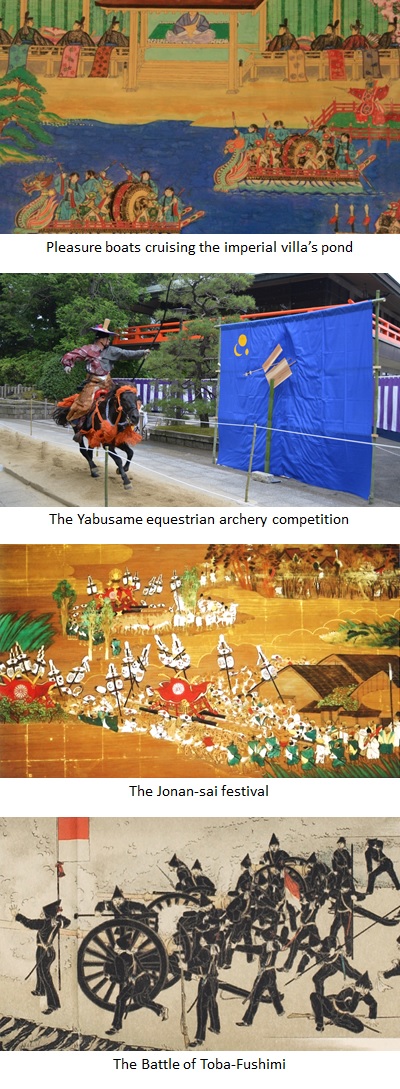- Jonangu exudes the elegant atmosphere of the Heian Aristocracy
- Jonangu, which literally means ‘the shrine south of the capital,’ was built
south of the newly established capital, Heian-kyo, in 794 to protect the
capital and ensure the nation’s peace. It enshrines the deity of the nation’s
territory, the deity of bravery, and the female deity of safe childbirth
and child rearing. Successive emperors and retired emperors visited the
shrine to pray against calamity striking from inauspicious directions,
and to pray for the peace and security of the imperial court.
As the guardian of construction, transportation and travel, Jonangu continues to attract worshipers from around Japan seeking directional protection against misfortune. Many petition for safe sightseeing during their visit to Kyoto. The shrine grounds echo every day with the ring of the bells the shrine maidens hold as they perform sacred dances. The main shrine and other structures built in traditional styles engender the elegant atmosphere of the ancient capital.
Jonangu’s extensive garden, Rakusuien, which covers approximately 30,000 sq. meters is striking, no matter the season. Kyokusui-no-Utage, which is held in the garden twice annually in the spring and fall, is a renowned event dating back to Heian Period and recreates the gracefulness of the times. - History
 The Toba area – south of the ancient capital, Heian-kyo – lay along a major
transport route into and out of the city. Jonangu was built here in 794,
when Heian-kyo was founded, to protect the capital, and the nation’s peace.
The surrounding area became popular as a retreat, and the imperial family
and aristocrats built their villas here.
The Toba area – south of the ancient capital, Heian-kyo – lay along a major
transport route into and out of the city. Jonangu was built here in 794,
when Heian-kyo was founded, to protect the capital, and the nation’s peace.
The surrounding area became popular as a retreat, and the imperial family
and aristocrats built their villas here.
In 1086, retired Emperor Shirakawa built a resplendent villa that covered 2 sq. km, encircling Jonangu. After he began ruling from the villa, known as either Jonan Rikyu or Toba Rikyu, it became the center of politics and culture. And the elegant Heian culture flourished with poetry-composition gatherings, sumptuous banquets, and pleasure boat cruises being held here. Jonangu’s fall festival, Jonan-sai, was a grand affair. People flocked to view the mikoshi portable-shrine parade, sacred dances and music of the shrine maidens, and heroic horse racing. They cheered during the Yabusame equestrian archery competition as the warriors showed off their archery skills and horsemanship.
Before long, the warriors tasked with guarding the retired emperors and aristocrats became more powerful than the aristocrats. The struggle between themselves culminated in a battle for supremacy between the Taira (Heishi) and Minamoto (Genji) clans. After five years of war, the Minamoto clan won and took political control, establishing a shogunate in 1192 in Kamakura. In 1221, the retired Emperor Go-Toba gathered warriors to Jonan Rikyu under the guise of holding a Yabusame tournament in an attempt to overthrow the Kamakura shogun; thus sparking the start of the Jokyu War. The shogun won and established a military government.
In the Edo Period (1603–1868), everyone from the imperial household to the common folk worshipped at Jonangu. One of the highlights for inhabitants of the surrounding villages was the Jonan-sai fall festival, during which parishioners paraded three mikoshi portable shrines. Imperially appointed shoguns and their military governments ruled Japan for close to 700 years.
In January 1868, the boom of the cannons from the pro-imperialist Satsuma Domain’s camp, which was set up outside Jonangu along the approach, marked the beginning of the Battle of Toba-Fushimi against the Shogun’s forces. Having put an end to the shogunate’s power, the Satsuma troops returned to Jonangu victorious and thanked the residing deities for their divine protection resulting in their victory. The allied forces of the Satsuma, Choshu and Tosa domains dominated the newly established government with the emperor as absolute monarch. Jonangu, since its foundation, has been the historical stage for the dawn of new eras.
English Page Top(Page of top) Festivals Precinct Garden Amulets Access